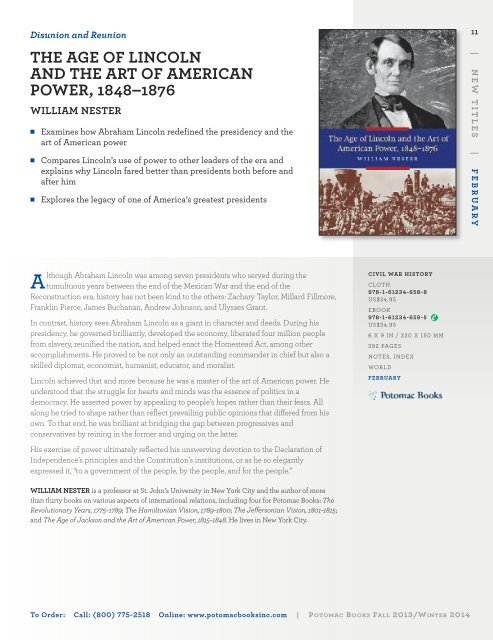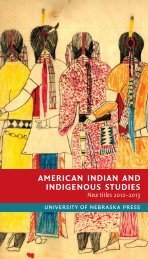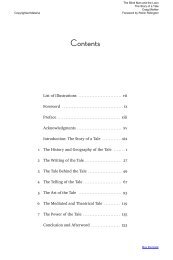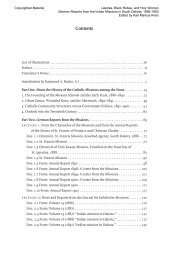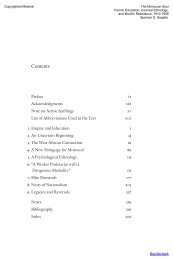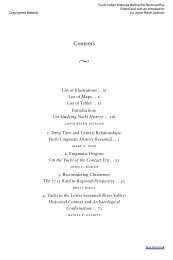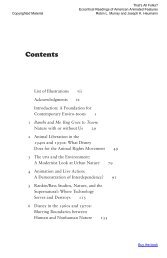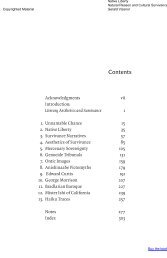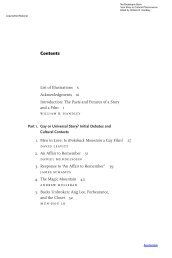Order Form Potomac Books Fall 2013/Winter 2014 - University of ...
Order Form Potomac Books Fall 2013/Winter 2014 - University of ...
Order Form Potomac Books Fall 2013/Winter 2014 - University of ...
You also want an ePaper? Increase the reach of your titles
YUMPU automatically turns print PDFs into web optimized ePapers that Google loves.
Disunion and Reunion<br />
THE AGE OF LINCOLN<br />
AND THE ART OF AMERICAN<br />
POWER, 1848–1876<br />
WILLIAM NESTER<br />
■<br />
■<br />
■<br />
Examines how Abraham Lincoln redefined the presidency and the<br />
art <strong>of</strong> American power<br />
Compares Lincoln’s use <strong>of</strong> power to other leaders <strong>of</strong> the era and<br />
explains why Lincoln fared better than presidents both before and<br />
after him<br />
Explores the legacy <strong>of</strong> one <strong>of</strong> America’s greatest presidents<br />
11<br />
| N E W T I T L E S | F E B R U A R Y<br />
Although Abraham Lincoln was among seven presidents who served during the<br />
tumultuous years between the end <strong>of</strong> the Mexican War and the end <strong>of</strong> the<br />
Reconstruction era, history has not been kind to the others: Zachary Taylor, Millard Fillmore,<br />
Franklin Pierce, James Buchanan, Andrew Johnson, and Ulysses Grant.<br />
In contrast, history sees Abraham Lincoln as a giant in character and deeds. During his<br />
presidency, he governed brilliantly, developed the economy, liberated four million people<br />
from slavery, reunified the nation, and helped enact the Homestead Act, among other<br />
accomplishments. He proved to be not only an outstanding commander in chief but also a<br />
skilled diplomat, economist, humanist, educator, and moralist.<br />
Lincoln achieved that and more because he was a master <strong>of</strong> the art <strong>of</strong> American power. He<br />
understood that the struggle for hearts and minds was the essence <strong>of</strong> politics in a<br />
democracy. He asserted power by appealing to people’s hopes rather than their fears. All<br />
along he tried to shape rather than reflect prevailing public opinions that differed from his<br />
own. To that end, he was brilliant at bridging the gap between progressives and<br />
conservatives by reining in the former and urging on the latter.<br />
His exercise <strong>of</strong> power ultimately reflected his unswerving devotion to the Declaration <strong>of</strong><br />
Independence’s principles and the Constitution’s institutions, or as he so elegantly<br />
expressed it, “to a government <strong>of</strong> the people, by the people, and for the people.”<br />
CIVIL WAR HISTORY<br />
CLOTH<br />
978-1-61234-658-8<br />
US$34.95<br />
EBOOK<br />
978-1-61234-659-5<br />
US$34.95<br />
6 X 9 IN / 230 X 150 MM<br />
392 PAGES<br />
NOTES, INDEX<br />
WORLD<br />
FEBRUARY<br />
WILLIAM NESTER is a pr<strong>of</strong>essor at St. John’s <strong>University</strong> in New York City and the author <strong>of</strong> more<br />
than thirty books on various aspects <strong>of</strong> international relations, including four for <strong>Potomac</strong> <strong>Books</strong>: The<br />
Revolutionary Years, 1775–1789; The Hamiltonian Vision, 1789–1800; The Jeffersonian Vision, 1801–1815;<br />
and The Age <strong>of</strong> Jackson and the Art <strong>of</strong> American Power, 1815–1848. He lives in New York City.<br />
To <strong>Order</strong>: Call: (800) 775-2518 Online: www.potomacbooksinc.com | POTOMAC BOOKS FALL <strong>2013</strong>/WINTER <strong>2014</strong>


